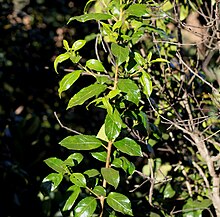Rhamnus prinoides, the shiny-leaf buckthorn, is an African shrub or small tree in the family Rhamnaceae. Commonly referred to as "gesho" it was first scientifically described by French botanist Charles Louis L'Héritier de Brutelle in 1789.[2]
| Shiny-leaf buckthorn | |
|---|---|

| |
| Habit of Rhamnus prinoides | |
| Scientific classification | |
| Kingdom: | Plantae |
| Clade: | Tracheophytes |
| Clade: | Angiosperms |
| Clade: | Eudicots |
| Clade: | Rosids |
| Order: | Rosales |
| Family: | Rhamnaceae |
| Genus: | Rhamnus |
| Species: | R. prinoides
|
| Binomial name | |
| Rhamnus prinoides | |
| Synonyms | |
| |
Description
editRhamnus prinoides occur from Ethiopia, Eritrea, and Kenya to South Africa at medium to high altitudes. They grow near streams or along forest margins. The small edible fruits are shiny red and berry-like.
Uses
editThe Rhamnus prinoides plant has many uses amongst the inhabitants of Africa. All parts of the plant are harvested and used for nutrition, medicine or religious purposes. Gesho, as it is known in Ethiopia and Eritrea, has a considerable value in these countries. It is one of the most precious crops used both locally for domestic use, and fabricated products industrially.[citation needed]
In Ethiopia and Eritrea, where the plant is known as gesho or gešo,[3] it is used in a manner similar to hops. The stems are boiled and the extract mixed with honey to ferment a mead called tej in Amharic and myes in Tigrinya.[4]
It is also used in the brewing of tella (siwa in Tigrinya), an Ethiopian and Eritrean beer.[5] This local drink is made from gesho as a major ingredient. Gesho leaves are sundried and pounded with mortar and pestle into flour. Barley malt is prepared and sundried and ground. These two ingredients are mixed, in a proportion that varies from maker to maker, and fermented 3 to 5 days on average. Finger millet (or sorghum and maize flour regionally) are baked, and finally mixed with the fermented solution. After 1–2 days of fermentation, the tella can be filtered and consumed in a drink locally called guesh (tsiray in Tigrinya). In Central Kenya the plant is known as "Mûkarakinga" and it is believed to be medicinal. The bark of the plant is cut, boiled and then added to soup.
Gallery
edit-
Foliage
-
Flower
-
Unripe fruit
-
Ripe fruit
References
edit- ^ Botanic Gardens Conservation International (BGCI); IUCN SSC Global Tree Specialist Group (2020). "Rhamnus prinoides". IUCN Red List of Threatened Species. 2020: e.T146405653A146444001. doi:10.2305/IUCN.UK.2020-2.RLTS.T146405653A146444001.en. Retrieved 3 April 2024.
- ^ "Rhamnus prinoides L'Hér". Germplasm Resources Information Network. Agricultural Research Service, United States Department of Agriculture. Retrieved 24 October 2010.
- ^ Pankhurst, Rita. "Gešo". In Encyclopaedia Aethiopica: D-Ha, edited by Siegbert Uhlig. 773. Wiesbaden, Germany: Harrassowitz Verlag, 2005
- ^ Richard Pankhurst, Economic History of Ethiopia (Addis Ababa: Haile Selassie I University, 1968), p. 194.
- ^ Amborn, Hermann. Sewa in Tigringa "Ṭälla." In Encyclopaedia Aethiopica: O-X: Vol. 4, edited by Siegbert Uhlig. 848-49. Wiesbaden: Harrassowitz, 2010.
- "Rhamnus prinoides". PlantZAfrica.com. Retrieved 2010-03-04.
- Trees of Southern Africa, K C Palgrave, 1984 ISBN 0-86977-081-0
